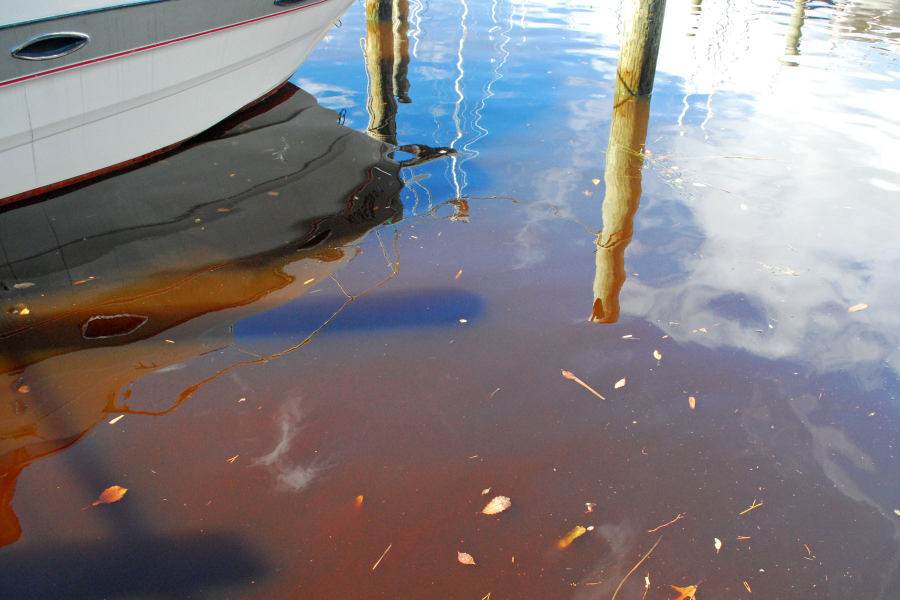How algae blooms impact the Bay

Algae is a crucial producer of oxygen and source of food for marine life in the Chesapeake Bay, but too much can be an indicator of pollution.
Algae is classified as any aquatic organism that produces oxygen through photosynthesis. The size of algae ranges from tiny microscopic cells floating in the water column (phytoplankton) to large mats of visible "macroalgae" (seaweed) that grow on bottom sediments.
However, when algae populations explode to unusually high numbers, they create algae blooms which can:
- Block sunlight that is vital for underwater grasses.
- Impede filter-feeders from obtaining food.
- Produce smelly surface scum.
- Consume dissolved oxygen when the algae die and decompose.
In addition, certain algae can also produce harmful chemicals that are toxic to humans, wildlife and aquatic life. Fortunately, of the more than 700 species of algae in Chesapeake Bay, less than 2% of them are believed to have the ability to produce toxic substances.
What causes algae blooms?
Algae blooms are primarily fueled by excess nutrients (nitrogen and phosphorus) entering waterways, which come from agriculture, air pollution, wastewater treatment plants, and stormwater runoff from lawns, gardens and paved surfaces.
The nutrients cause algae to grow, particularly phytoplankton. Oysters and other filter feeders can't consume all the algae that forms in the water, so uneaten phytoplankton sink to the bottom of the Bay and decompose which depletes the water of oxygen.
Decomposing phytoplankton, combined with high summer water temperatures, can cause large areas of the deepest parts of the Bay's mainstem to have little or no oxygen.
Impacts to the Bay
Algae blooms cover the surface of the water and depending on the type of algae, can be green, blue-green, red or brown. The vegetation blocks sunlight from reaching other underwater grasses (critical habitat for marine life) which causes them to die.
The blooms also create “dead zones” which are areas that do not have enough oxygen to support fish, crabs and other marine life. There are over 166 identified dead zones across the nation and in 2021, the average size of the dead zone in the Chesapeake Bay was 1.5 cubic miles and lasted for 141 days.
Algae blooms have economic consequences as well as environmental and health impacts. Algae blooms are unsightly, smelly and are sometimes toxic which closes beaches and reduces tourism. Since crab, oyster and fish populations decline from the lack of oxygen in areas with algae blooms, catch from commercial and recreational fishing is also impacted.
What can you do?
Residents of the Bay watershed can help give the Bay's crabs, fish and other species some relief from algae blooms by taking simple actions to reduce nutrient pollution, including driving less, upgrading septic systems, picking up pet waste, reducing the use of lawn fertilizers and installing rain gardens and rain barrels.
If you have property along a shoreline, you can also reduce nutrient pollution by expanding your wetland grasses.
Bay Program partners actively monitor the region's waterways for algae blooms, so that if one occurs the public can be notified to protect human health. Residents are also asked to keep a watchful eye out for possible algae blooms and are urged to report suspected algae blooms to their respective state environmental agency:
- To report algae blooms in Maryland contact Maryland Department of the Environment at (800) 285-8195 or report on DNR’s Eyes on the Bay website.
- To report algae blooms in Virginia call (888) 238-6154.

Comments
Hello my teacher is doing an assignment on algae blooms and this site was very helpful on that and help me find what they did and all of that in the Chesapeake bay. thank you
According to one report in 2016, the four main economic impacts from harmful algal blooms come from damage to human health, fisheries, tourism and recreation, and the cost of monitoring and management of area where blooms appear.
I am doing a science project (Public Service Announcement) and this is the topic. This site has a lot f good information and really helped my group and I complete it. I definitely recommend this site for research on the Chesapeake Bay.
I am doing a project on the Food Chain on the Chesapeake Bay in my science class. And its due today and thanks to this i finished. Very important information on here that helped my alot. Thanks!
I'm doing a science project and we are doing storm drain art. we are doing a painting of a Chesapeake bay scene on a storm drain at my school. this was very helpful to get facts. thanks for the info
Hi! My name is Dina and I am doing a projest in science class. It is on Phytoplankton and I found out some really neat things. I got inspired when my science teacher showed me a video of how to save the C. Bay. I then went to the local pet store and asked them for a tank of salt water. I then called many people but I found someone who breeded aquatic animals. I asked if I could have a special order of 72 oysters to breed. I mean, this tank was huge! I had to fill it up! However, I had to be very patient and wait for the oysters to be old enough to reperduce. I finally got the call and headed to pick them up. I put them in the tank and so sediment, plants, and bay-familiar fish. Now, I basically have my own coral reef!
Thank you!
Your comment has been received. Before it can be published, the comment will be reviewed by our team to ensure it adheres with our rules of engagement.
Back to recent stories